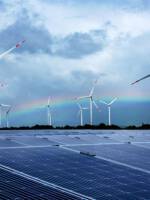
Statistics from the Center for People and Nature (under the Vietnam Union of Science and Technology Associations (VUSTA)) reveal that by the end of November 2022, Vietnam had had about 29.4 million carbon credits issued from 276 projects in the framework of the Clean Development Mechanism (CDM) for the mandatory carbon market, mainly in the fields of hydropower, renewable energy, biomass power, and energy efficiency. The voluntary carbon market has been formed with 32 projects, releasing 5.75 million carbon credits in the fields of hydropower, solar power, and wind power.
According to Director To Xuan Phuc of the Forestry Policy, Trade and Finance Program (under Forest Trends – a non-profit organization that encourages the maintenance of sustainable ecosystems and the connection of economic tools to achieve this goal), Vietnam has a high potential when taking part in the carbon market. Vietnamese forests are able to earn a huge revenue from carbon credits thanks to their huge surface area of 14.7 million hectares, which absorb about 70 million tonnes of carbon annually.
The Government is now developing a plan to operate the carbon market under the mandatory mechanism in the future. Accordingly, in the 2021-2027 period, Vietnam will focus on preparing regulations to manage carbon credits, to identify exchange quotas, to control greenhouse gas emission, and to build an operational mechanism for a carbon credit trading floor. After that is the release of instructions for carbon credit measurement and report, for the establishment of a carbon credit trading floor, and for the development of a national greenhouse gas inventory system. The piloting time will come next.
Earning VND80 billion (US$3.16 million) from selling carbon credits, Quang Binh Province has been chosen as a place for piloting the transfer of emission reduction results and financial management of emission reduction payments in the North Central region according to Decree No.107/2022/ND-CP, issued on December 28, 2022 by the Government.
The province received 80 percent (equivalent to VND235 billion or $9.27 million) from the agreement to pay for emission reduction from natural forests. In 2023, it also obtained VND82.48 trillion ($3.25 billion) to deliver to more than 10,700 households and communities as well as 16 organizations who are forest owners, along with 71 wards and 9 organizations in charge of forest management.
The Vietnam Forest Protection and Development Fund has paid over VND72 billion ($2.84 million) to those working in this field, accounting for 88 percent of the plan. The rest is used for the financial plan of 2024. This revenue has greatly contributed to increasing the income of local people who are depending on forest to earn a living in Quang Binh Province.
Other provinces also receiving money from the sale of carbon credits include Thanh Hoa (VND162.6 billion – $6.41 million), Nghe An (VND285 billion – $11.24 million), Ha Tinh (VND123 billion – $4.85 million), Quang Tri (VND51 billion – $2 millon), and Thua Thien-Hue (VND107 billion – $4.22 million).
To achieve such an impressive result, in the 2013-2016 period, Quang Binh Province actively joined in the project “Supporting to Carry out REDD+ in Vietnam”, held by the Forestry Carbon Partnership Fund via the sponsor of the World Bank. The province also worked with consultation units to form a forest reference for emission route in the North Central region, which becomes a foundation for the calculation of emission, carbon absorbance and storing in Vietnamese forests.
The results show that Quang Binh Province is able to reduce 4.5 million tonnes of carbon compared to the reference while promoting forest services and biodiversity preservation alongside ecotourism development for sustainable forestry growth. The province also aims at planting large timber forests and preparing suitable measures for sustainable forest development or forest credit issuance.
Head Nguyen Van Minh of the Office for Economy and Climate Change Information (under the Department of Climate Change in the Ministry of Natural Resources and Environment) stressed that the carbon credit market will help Vietnam increase its competitiveness in foreign capital attraction and export activities, especially to the markets with high demands on environment protection.
To have a carbon credit, an organization must follow seven mandatory steps of developing project design documents, writing a letter for project approval, carrying out project evaluation, registering for the project, checking the amount of reduced greenhouse gas emission by the project, having an independent unit to recheck this figure, and issuing a corresponding number of carbon credits. Since this is a rather complicated process, interested organizations should actively learn about related legal regulations.
Dr. Pham Van Dai from Fulbright School of Public Policy and Management said that to sustainably and effectively operate the carbon credit market, the Government should urgently perfect corresponding legal regulations and technical standards concerning transaction mechanisms. Vietnam should classify carbon credits as a resource that needs protection. Also, it is necessary to save domestic carbon credits for Vietnamese businesses so that they do not need to buy from others with high prices when participating in the global carbon credit market.
Director Nguyen Toan Thang of the HCMC Department of Natural Resources and Environment shared that when adopting Resolution 98/2023/QH15, HCMC has selected the two projects of “Replacing Normal Streetlight Bulbs with LED ones” and ‘Installing Solar Panels on Rooftops of State-owned Buildings’ in order to join in the carbon market. The project ‘Piloting a financial mechanism to implement measures to reduce greenhouse gas emissions according to the carbon credit exchange mechanism’ is a joint effort of the HCMC Finance Department and the HCMC Natural Resources and Environment Department.
The latter will also collaborate with the four ministries of Industry and Trade, Transport, Agriculture and Rural Development, and Natural Resources and Environment to identify the contribution proportion of emission reduction of HCMC to the national one before trading carbon credits. This department will also work with the HCMC Finance Department and the Natural Resources and Environment Ministry in calculating prices for carbon credits and selecting suitable credits in piloting projects to sell.
It is expected that carbon credit trading activities will attract both domestic and foreign investors to green projects, offer jobs to the local, and facilitate the city’s economy. This is also to implement the commitment of HCMC to cope with climate change, and to transform HCMC into a hub for carbon credit trading of the region and the world.
Assoc. Prof. Dr. Nguyen Dinh Tho, Head of the Institute of Strategy and Policy on Natural Resources and Environment (under the Ministry of Natural Resources and Environment) informed that in 2020, the green economy of Vietnam earned $6.7 billion (accounting for 2 percent of the national GDP) and provided jobs for 400,000 laborers.
However, green growth in Vietnam still encounters various obstacles like an inexperienced green finance system, loose implementation of environment regulations among businesses, the low awareness of the community in green growth and sustainable development. Vietnam should adopt suitable measures to ensure the consistency of law observation while promoting new financial mechanisms for green growth.
Minh Hai – Translated by Thanh Tam




